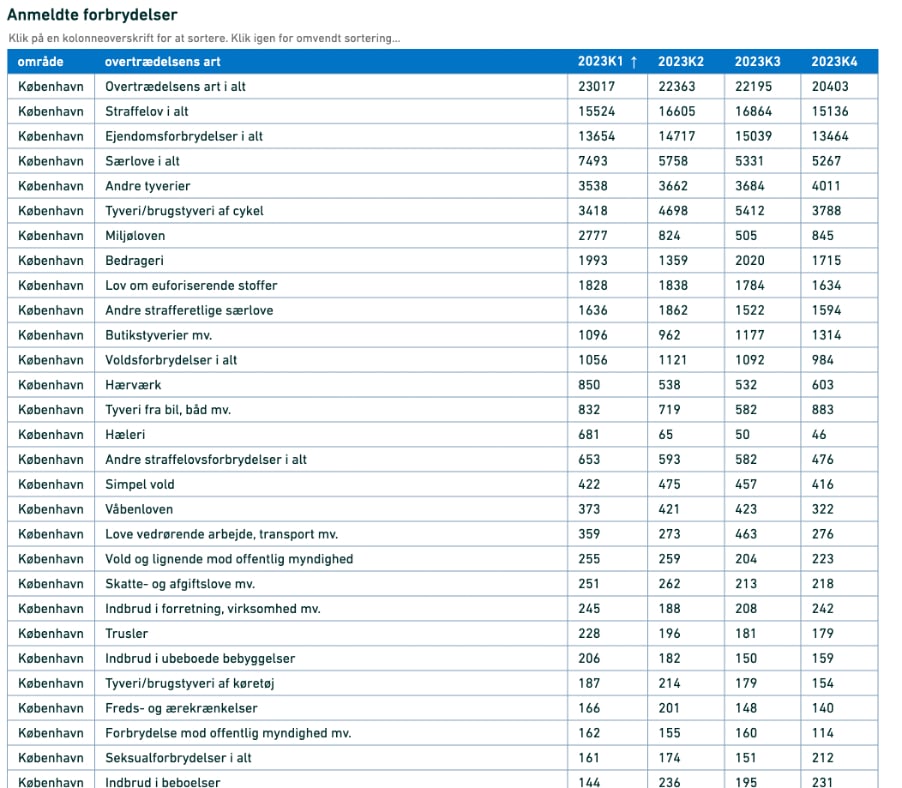Copenhagen frequently features high up on rankings of “most liveable city in the world” for many reasons, including how safe the city of about 1.3 million people is.
In its 2023 Global Liveability Index, the Economist Intelligence Unit (EIU) gave Copenhagen an overall second place behind Austrian capital Vienna.
Both cities received the highest possible score in “Stability”, which is measured based on several indicators, including the prevalence of petty crime and violent crime.
But, of course, even if the city is safe, it doesn’t mean there is no crime in the capital.
Drawing the relevant numbers from national agency Statistics Denmark’s data bank shows a total of 87,978 crimes were reported to police in 2023. That compares to 81,216 crimes reported in 2022, when some Covid-19 restrictions were still in place at the beginning of the year.
It should be noted that the figures refer to crimes reported to police in the Copenhagen Municipality (and not other municipalities which also make up the Greater Copenhagen area such as Frederiksberg, whose residents count towards the city’s population total).
Crimes reported to police (anmeldte forbrydelser in Danish) are recorded by the National Police (Rigspolitiet), from where Statistics Denmark takes the data.
The stats agency also has a data bank for court verdicts (domme), which covers crimes that have received a verdict ranging from prison to a fine to acquittal. These figures are only available nationally in the databank, however, and were therefore not used for this article.
On its website, Statistics Denmark breaks down its national crime figures into four main categories: sexual offences, violent crime, crimes against property and other violations of the criminal law.
The most common type by far among the national data is crimes against property, with up to ten times as many instances as any of the other three types.
There are further crime types that do not fit into these categories, primarily traffic offences and violations of særlov or “special laws”. These include drugs and weapons offences and tax evasion.
READ ALSO: EXPLAINED: How gun control laws work in Denmark
Each of the four main types (sexual offences, violent crime, crimes against property and other violations) have additional subcategories.
These subcategories also appear in the more detailed breakdown by municipality – Copenhagen, in the case of this article.
Usually, it is logical to see which crime falls under which of the four types. For example, rape and all other sexual offences all come under the first type; affray, assault and public order offences under the second; arson, burglary and vandalism the third; and fraud, drug smuggling or perjury the fourth.

The above table, a screenshot of data pulled from the Statistics Denmark databank, shows crime reports divided into both the four larger categories, and the many subcategories, broken down into the four quarters of 2023.
The highest row shows the overall number of all crimes reported in Copenhagen in each of the quarters of 2023. The second row relates to violations of the criminal law.
The third row displays “crimes against property”, meaning this type reflects the national data as the most common type of crime reported to police.
Further down the list comes the totals for violent crimes (voldsforbrydelser i alt), while near the bottom of the screen shot (but not the bottom of the list) is the total number of reported sex crimes (seksualforbrydelser i alt), which reaches 698 for last year once each when the four quarters are added together.
READ ALSO: What can Denmark do to protect women at risk from domestic violence?
Once we get into individual crime types, we can see that theft is the most commonly reported. “Other thefts” and “Bicycle theft” fill the fourth and fifth rows on the table.
Adding each of the columns for the four quarters, we can see that 17,316 bicycle thefts were reported in Copenhagen last year.
The next most frequently reported crimes relate to violations of the environmental protection law, miljøloven, followed by fraud (bedrageri) and violations of narcotics laws (lov om euforiserende stoffer).
The other crime type to break 1,000 reports within any given quarter of 2023 is shoplifting etc (butikstyverier mv.).
Vandalism, stealing from cars or boats, and selling stolen goods are the next three most common individual crime types.
The burglary statistics are distinct from reports of the more aggravated type robbery (røveri), which appears further down the list and is in double figures (79, 96, 88, 95) for quarterly reports.
Violations of Denmark’s weapons law – which relates to illegal possession and use of firearms and restricted knives as well as other weapons – were reported to police in Copenhagen a total of 1,539 times in 2023. The quarterly figures can be seen in the row titled Våbenloven.



 Please whitelist us to continue reading.
Please whitelist us to continue reading.
Member comments